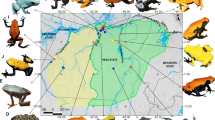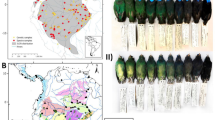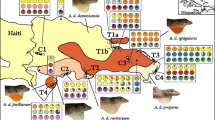Abstract
The evolutionary mechanisms causing intraspecific diversity in aposematic color and pattern remain enigmatic. The strawberry poison frog (Oophaga pumilio) has diversified into a broad array of colors that span the visible spectrum. The most divergent phenotypes of O. pumilio are restricted to separate islands in the Bocas del Toro archipelago in western Panama, whereas throughout the majority of its range (from Nicaragua to western Panama) this species exhibits a single red phenotype. During the Holocene, sea-levels increased and changes in climate caused shifts in habitat through time. In the Bocas del Toro archipelago, rising sea-levels isolated previously connected populations in higher elevation habitats (forming islands). In this study we use historic measures of demography, ancestral distribution estimates, spatiotemporally explicit demographic models and genetic simulations to investigate the genetic consequences of the isolation due to sea-level changes and demographic processes mediated by recent climatic fluctuations. We then evaluate the role of these factors in the evolution of color in O. pumilio by measuring and comparing the deep coalescence of a neutrally evolving nuclear gene and a hypothetical autosomal coloration gene. Our results support a major role for recent population expansion and reduced gene flow (from isolation on islands) in the diversification of color across populations.







Similar content being viewed by others
References
Akaike H (1974) A new look at the statistical model identification. IEEE Trans Autom Control 19:716–723
Andersen KK, Azuma N, Barnola JM et al (2004) High resolution record of Northern Hemisphere climate extending into the last interglacial period. Nature 431:147–151
Anderson RP, Handley CO (2002) Dwarfism in insular sloths: biogeography, selection, and evolutionary rate. Evolution 56(5):1045–1058
Arenas M, Ray N, Currat M, Excoffier L (2012) Consequences of range contractions and range shifts on molecular diversity. Mol Biol Evol 29(1):207–218
Bee MA (2003) A test of the ‘dear enemy effect’ in the strawberry dart-poison frog (Dendrobates pumilio). Behav Ecol Sociobiol 54:601–610
Bielejec F, Rambaut A, Suchard MA, Lemey P (2011) SPREAD: spatial phylogenetic reconstruction of evolutionary dynamics. Bioinformatics 27:2910–2912
Braconnot P, Otto-Bliesner B, Harrison S et al (2007) Results of PMIP2 coupled simulations of the Mid-Holocene and Last Glacial Maximum–Part 1: experiments and large-scale features. Clim Past 3:261–277
Brown JL, Knowles LL (2012) Spatially explicit models of dynamic histories: examination of the genetic consequences of Pleistocene glaciation and recent climate change on the American Pika. Mol Ecol 21(15):3757–3775
Brown JL, Maan ME, Cummings ME, Summers K (2010) Evidence for selection on coloration in a Panamanian poison frog: a coalescent-based approach. J Biogeogr 37(5):891–901
Brown JL, Twomey E, Amézquita A et al (2011) A taxonomic revision of the Neotropical poison frog genus Ranitomeya (Amphibia: Dendrobatidae). Zootaxa 3083:1–120
Brust DG (1993) Maternal brood care by Dendrobates pumilio: a frog that feeds its young. J Herpetol 27(1):96–98
Bunnell P (1973) Vocalizations in the territorial behavior of the frog Dendrobates pumilio. Copeia 1973(2):277–284
Coates AG, Obando JA (1996) The geologic evolution of the Central American Isthmus. In: Jackson JBC, Budd AF, Coates AG (eds) Evolution and environment in tropical America. University of Chicago Press, Chicago, IL, pp 21–56
Coates AG, Collins LS, Aubry MP, Berggren WA (2004) The geology of the Darien, Panama, and the late Miocene–Pliocene collision of the Panama arc with northwestern South America. Geol Soc Am Bull 116:1327–1344
Colinvaux PA (1991) A commentary on: palaeoecological background: neotropics. Clim Change 19:49–51
Colinvaux PA, Liu K-B, de Oliveira P et al (1996) Temperature depression in the lowland tropics in glacial times. Clim Change 32:19–33
Currat M, Ray N, Excoffier L (2004) SPLATCHE: a program to simulate genetic diversity taking into account environmental heterogeneity. Mol Ecol Notes 4:139–142
Daly JW, Myers CW (1967) Toxicity in Panamanian poison frogs (Dendrobates): some biological and chemical aspects. Science 156:970–973
Darst CR, Cummings ME, Cannatella DC (2006) A mechanism for diversity in warning signals: conspicuousness versus toxicity in poison frogs. Proc Natl Acad Sci USA 103:5852–5857
Darwin C (1887) The life and letters of Charles Darwin: including an autobiographical chapter, edited by his son Francis Darwin. Murray, London
Donnelly MA (1987) Territoriality in the poison-dart frog Dendrobates pumilio (Anura: Dendrobatidae). PhD dissertation, University of Miami
Donnelly MA (1989) Demographic effects of reproductive resource supplementation in a Territorial Frog, Dendrobates pumilio. Ecol Monogr 59(3):207–221
Drummond AJ, Rambaut A (2007) BEAST: Bayesian evolutionary analysis by sampling trees. BMC Evol Biol 7:214
Drummond AJ, Rambaut A, Shapiro B, Pybus OG (2005) Bayesian coalescent inference of past population dynamics from molecular sequences. Mol Biol Evol 22:1185–1192
Drummond AJ, Suchard MA, Xie D, Rambaut A (2012) Bayesian phylogenetics with BEAUti and the BEAST 1.7. Mol Biol Evol 29:1969–1973
Dumont BL, Payseur BA (2008) Evolution of the genomic rate of recombination in mammals. Evolution 62:276–294
Edmonds CA, Lillie AS, Cavalli-Sforza LL (2004) Mutations arising in the wave front of an expanding population. Proc Natl Acad Sci USA 101:975–979
Excoffier L, Lischer HEL (2010) Arlequin suite ver 3.5: a new series of programs to perform population genetics analyses under Linux and Windows. Mol Ecol Resour 10:564–567
Excoffier L, Novembre J, Schneider S (2000) SIMCOAL: a general coalescent program for the simulation of molecular data in interconnected populations with arbitrary demography. J Hered 91:506–510
Excoffier L, Foll M, Petit RJ (2009) Genetic consequences of range expansions. Annu Rev Ecol Evol Syst 40:481–501
Fleming K, Johnston P, Zwartz D et al (1998) Refining the eustatic sea-level curve since the Last Glacial Maximum using far- and intermediate-field sites. Earth Planet Sci Lett 163(1–4):327–342
Galbreath KE, Hafner DJ, Zamudio K (2009) When cold is better: climate-driven elevation shifts yield complex patterns of diversification and demography in an alpine specialist (American Pika, Ochotona princeps). Evolution 63:2848–2863
GIBCO (2012) GEBCO digital atlas on behalf of the Intergovernmental Oceanographic Commission and the International Hydrographic Organization as part of the general bathymetric chart of the oceans. British Oceanographic Data Centre, Liverpool, UK
Graham CH, van der Wal J, Phillips SJ, Moritz C, Williams SE (2010) Dynamic refugia and species persistence: tracking spatial shifts in habitat through time. Ecography 33:1062–1069
Grant T, Frost DR, Caldwell JP et al (2006) Phylogenetic systematics of dart-poison frogs and their relatives (Amphibia: Athesphatanura: Dendrobatidae). Bull Am Mus Nat Hist 299:1–262
Grant WS, Liu M, Gao T, Yanagimoto T (2012) Limits of Bayesian skyline plot analysis of mtDNA sequences to infer historical demographies in Pacific herring (and other species). Mol Phylogenet Evol 65(1):203–212
Hagemann S, Pröhl H (2007) Mitochondrial paraphyly in a polymorphic poison frog species (Dendrobatidae; D. pumilio). Mol Phylogenet Evol 45:740–747
Hauswaldt JS, Ludewig A-K, Vences M, Pröhl H (2010) Widespread co-occurrence of divergent mitochondrial haplotype lineages in a Central American species of poison frog (Oophaga pumilio). J Biogeogr 38:711–726
Hegna R, Saporito RA, Donnelly MA (2012) Not all colors are equal: predation and color polytpism in the aposematic poison frog Oophaga pumilio. Evol Ecol. doi:10.1007/s10682-012-9605-z
Hewitt GM (1996) Some genetic consequences of iceages, and their role in divergence and speciation. Biol J Linn Soc 58:247–276
Hijmans RJ, Cameron SE, Parra JL, Jones PG, Jarvis A (2005) Very high resolution interpolated climate surfaces for global land areas. Int J Climatol 25:1965–1978
Ho SY, Phillips MJ, Cooper A, Drummond AJ (2005) Time dependency of molecular rate estimates and systematic overestimation of recent divergence times. Mol Biol Evol 22:1561–1568
Ho SY, Lanfear R, Bromham L, Phillips MJ, Soubrier J, Rodrigo AG, Cooper A (2011) Time-dependent rates of molecular evolution. Mol Ecol 20:3087–3101
Klopfstein S, Currat M, Excoffier L (2006) The fate of mutations surfing on the wave of a range expansion. Mol Biol Evol 23:482–490
Lemey P, Rambaut A, Welch JJ, Suchard MA (2010) Phylogeography takes a relaxed random walk in continuous space and time. Mol Biol Evol 27:1877–1885
Limerick S (1980) Courtship behavior and oviposition of the poison-arrow frog Dendrobates pumilio. Herpetologica 36(1):69–71
Lohse K, James N, Stone GN (2011) Inferring the colonization of a mountain range-refugia vs. nunatak survival in high alpine ground beetles. Mol Ecol 20:394–408
Maan ME, Cummings ME (2008) Female preferences for aposematic signal components in a polymorphic poison frog. Evolution 62(9):2334–2345
Maan ME, Cummings ME (2009) Sexual dimorphism and directional sexual selection on aposematic signals in a poison frog. Proc Natl Acad Sci USA 106:19072–19077
Maan ME, Cummings ME (2012) Poison frog colors are honest signals of toxicity, particularly for bird predators. Am Nat 179(1):1–14
Maddison DR, Maddison WP (2005) MacClade 4: analysis of phylogeny and character evolution. Version 4.08a. http://macclade.org
Meuche I, Linsenmair KE, Pröhl H (2012) Intrasexual competition, territoriality and acoustic communication in male strawberry poison frogs (Oophaga pumilio). Behav Ecol Sociobiol 4:613–621
Milne GA, Long AJ, Bassett SE (2005) Modelling Holocene relative sea-level observations from the Caribbean and South America. Quat Sci Rev 24(10–11):1183–1202
Morgan K, O’ Loughlin S, Chen B et al (2011) Comparative phylogeography reveals a shared impact of Pleistocene environmental change in shaping genetic diversity within nine Anopheles mosquito species across the Indo-Burma biodiversity hotspot. Mol Ecol 20:4533–4549
Müller F (1879) Ituna and Thyridia; a remarkable case of mimicry in butterflies (R. Meldola translation). Proc R Entomol Soc 1879:20–29
Phillips SJ, Anderson RP, Schapire RE (2006) Maximum entropy modeling of species geographic distributions. Ecol Model 190:231–259
Piperno DR, Pearsall DM (1998) The origins of agriculture in the lowland Neotropics. Academic Press, San Diego
Posada D (2008) jModelTest: phylogenetic model averaging. Mol Biol Evol 25:1253–1256
Poulton EB (1890) The colours of animals: their meaning and use especially considered in the case of insects. Kegan Paul, Trench, Trubner and Co. Ltd., London
Pröhl H (1997) Territorial behavior of the strawberry poison-dart frog, Dendrobates pumilio. Amphib Reptil 18:437–442
Pröhl H, Berke O (2001) Spatial distributions of male and female strawberry poison frogs and their relation to female reproductive resources. Oecol 129:534–542
Pröhl H, Hödl W (1999) Parental investment, potential reproductive rates and mating system in the strawberry poison-dart frog Dendrobates pumilio. Behav Ecol Sociobiol 46:215–220
Pröhl H, Ostrowski T (2011) Behavioural elements reflect phenotypic colour divergence in a poison frog. Evol Ecol 25(5):993–1015
Pröhl H, Hagemann S, Karsch J, Hobel G (2007) Geographic variation in male sexual signals in strawberry poison frogs (Dendrobates pumilio). Ethology 113(9):825–837
Rambaut A, Drummond AJ (2009) Tracer v1.5. Available at http://beast.bio.ed.ac.uk/Tracer
Ray N, Currat M, Foll M, Excoffier L (2010) SPLATCHE2: a spatially explicit simulation framework for complex demography, genetic admixture and recombination. Bioinformatics 26:2993–2994
Reynolds RG, Fitzpatrick BM (2007) Assortative mating in poison-dart frogs based on an ecologically important trait. Evolution 61:2253–2259
Richards-Zawacki CL, Cummings ME (2011) Intraspecific reproductive character displacement in a polymorphic poison dart frog, Dendrobates pumilio. Evolution 65:259–267
Richards-Zawacki CL, Wang IJ, Summers KS (2012) Mate choice and the genetic basis for colour variation in a polymorphic dart frog: inferences from a wild pedigree. Mol Ecol 21:3879–3892
Rudh A, Rogell B, Höglund J (2007) Non-gradual variation in colour morphs of the Strawberry Poison Frog Dendrobates pumilio: genetic and geographical isolation suggest a role for selection in maintaining polymorphism. Mol Ecol 16:4284–4294
Rudh A, Rogell B, Håstad O, Qvarnström A (2011) Rapid population divergence linked with co-variation between coloration and sexual display in strawberry poison frogs. Evolution 65(5):1271–1282
Santos JC, Coloma LA, Summers K et al (2009) Amazonian amphibian diversity is primarily derived from late Miocene Andean lineages. PLoS Biol 7:448–461
Saporito R, Donnelly M, Garraffo H et al (2006) Geographic and seasonal variation in alkaloid-based chemical defenses of Dendrobates pumilio from Bocas del Toro, Panama. J Chem Ecol 32(4):795–814
Saporito RA, Donnelly MA, Jain P et al (2007) Spatial and temporal patterns of alkaloid variation in the poison frog Oophaga pumilio in Costa Rica and Panama over 30 years. Toxicon 50:757–778
Savage JM (2002) The amphibians and reptiles of Costa Rica: a herpetofauna between two continents, between two seas. University of Chicago Press, Chicago
Slatkin M, Maddison WP (1989) A cladistic measure of gene flow inferred from phylogenies of alleles. Genetics 123:603–613
Staudt K, Ospina SM, Mebs D, Pröhl H (2010) Foraging behaviour and territoriality of the strawberry poison frog (Oophaga pumilio) in dependence of the presence of ants. Amphib Reptil 31(2):217–227
Summers K, Earn D (1999) The cost of polygyny and the evolution of female care in poison frogs. Biol J Linn Soc 66:515–538
Summers K, Bermingham E, Weight L et al (1997) Phenotypic and genetic divergence in three species of dart-poison frogs with contrasting parental behavior. J Hered 88(1):8–13
Summers K, Symula R, Clough M, Cronin T (1999) Visual mate choice in poison frogs. Proc Roy B Biol Sci 266:2141–2145
Summers K, Cronin TW, Kennedy T (2003) Variation in spectral reflectance among populations of Dendrobates pumilio, the strawberry poison frog, in the Bocas del Toro Archipelago, Panama. J Biogeogr 30:35–53
Summers K, Cronin TW, Kennedy T (2004) Cross-breeding of distinct color morphs of the strawberry poison frog (Dendrobates pumilio) from the Bocas del Toro Archipelago, Panama. J Herpet 38(1):1–8
Symula R, Schulte R, Summers K (2001) Molecular phylogenetic evidence for a mimetic radiation in Peruvian poison frogs supports a Müllerian mimicry hypothesis. Proc Roy B Biol Sci 268:2405–2421
Tazzyman SJ, Iwasa Y (2010) Sexual selection can increase the effect of random genetic drift—a quantitative genetic model of polymorphism in Oophaga pumilio, the strawberry poison dart frog. Evolution 64(6):1719–1728
Voje KL, Hemp C, Flagstad Ø, Saetre GP, Stenseth NC (2009) Climatic change as an engine for speciation in flightless Orthoptera species inhabiting African mountains. Mol Ecol 18:93–108
Wallace AR (1867) Proc Entomol Soc Lond. March 4th: IXXX–IXXXi
Wang IJ (2011) Inversely related aposematic traits: reduced conspicuousness evolves with increased toxicity in a polymorphic poison-dart frog. Evolution 65:1637–1649
Wang IJ, Shaffer HB (2008) Rapid color evolution in an aposematic species: a phylogenetic analysis of color variation in the strikingly polymorphic strawberry poison-dart frog. Evolution 62:2742–2759
Wang IJ, Summers K (2010) Genetic structure is correlated with phenotypic divergence rather than geographic isolation in the highly polymorphic strawberry poison-dart frog. Mol Ecol 19(3):447–458
Weygoldt P (1980) Complex brood care and reproductive behaviour in captive poison-arrow frogs, Dendrobates pumilio O. Schmidt. Behav Ecol Sociobiol 7(4):329–332
Acknowledgments
We are indebted to M. Vences and S. Hauswaldt for their support and advice on this project. This material is based upon work supported by KAAD (Katholischer Akademischer Ausländer-Dienst) Ph. D scholarship (MCG) and by the National Science Foundation Grant No. 0905905 (JLB).
Author information
Authors and Affiliations
Corresponding author
Rights and permissions
About this article
Cite this article
Gehara, M., Summers, K. & Brown, J.L. Population expansion, isolation and selection: novel insights on the evolution of color diversity in the strawberry poison frog. Evol Ecol 27, 797–824 (2013). https://doi.org/10.1007/s10682-013-9652-0
Received:
Accepted:
Published:
Issue Date:
DOI: https://doi.org/10.1007/s10682-013-9652-0




